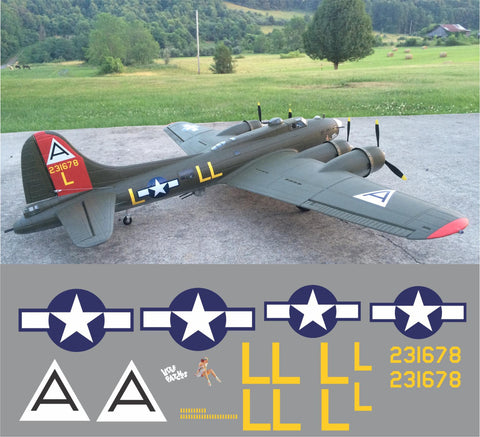Boeing B-17G-25-BO Flying Fortress 42-31678 “Little Patches” in Flight of 91st Bomb Group 401st Bomb Squadron, code LL-L 6 1944.
The name "Little Patches" was acquired after the aircraft's first combat mission with Lt William Major's crew when Frankfurt flak put many splinters through the ship. The damage was primarily cosmetic but the skin required numerous small aluminium patches prompting Lt Major to name the ship. Starcer's original pin-up painting portrayed a blonde wearing an Air Force cap.
"Little Patches" was considered a 'gas-hog' by the Major crew who were concerned on long haul missions that they might not make it home. The 21st Feb 44 mission to Poland prompted plans for an emergency landing in Sweden should it become necessary but the weather closed in that day and dictated a closer target.
After the 29th Mar 44 mission to Brunswick, "Little Patches" caught fire during maintenance and was so badly damaged that it was removed from operations and sent to the sub-depot for extensive repairs. It was not fit to return to combat flying until early in May when it was re-assigned to the 401st Bomb Squadron.
At least 34 different combat crews were assigned to "Little Patches" during its operational tour. The first pilot to take the ship after it was transferred into the 401st Sqn was Sam Newton -- immortalised in Bert Stiles' famous book 'Serenade to the Big Bird.' Stiles later flew as co-pilot with John Green on 29th July to Leipzig when "Little Patches" took 20mm cannon hits, caught fire and was forced from the formation to return alone. It flew to all the toughest targets including Schweinfurt, Regensburg, Augsburg, Munich, Merseburg, Frankfurt and Berlin (at least 8 times). Serious battle damage over Merseburg on 2nd November put the ship out of action for most of that month. Repaired, it was put back into combat and continued flying missions until the end. In the final month of war, "Little Patches" notched up nine raids -- the last being to Brandenburg on 20th April 1945.
Finally when it was all over, "Little Patches" landed just north of Berlin on 8th May to collect RAF prisoners of war and ferry them back to England. One month later, it took off from Bassingbourn for Valley in Wales on the first leg of the return flight to the USA and ultimate scrapping, piloted by Francis Breidenbach. After landing at Bradley Field, Connecticut, it passed on to Romulus Field, then Topeka and finally Kingman RFC, Arizona.
Photo by G.R. Baker

